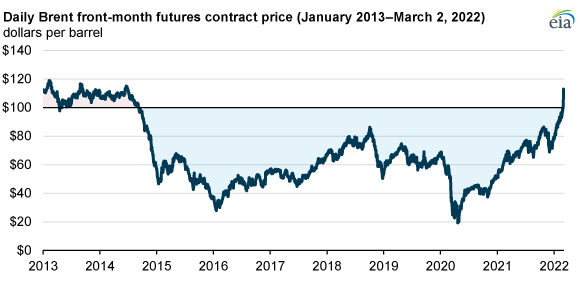Following reports that Russian forces invaded Ukraine on Thursday, February 24, the front-month futures price of both Brent and West Texas Intermediate (WTI) crude oil have increased to more than $100 per barrel (b). The front-month Brent contract price closed just below $115/b on Wednesday, March 2, after rising and settling above $100/b on February 28. The Brent crude oil price last rose above $100/b in late 2014. The front-month WTI contract price closed above $110/b on March 2, after first settling above $100/b on March 1.

Brent crude oil is a type of crude oil from the North Sea in Northwest Europe that is commonly used as a global benchmark. West Texas Intermediate crude oil is used as a U.S. benchmark. Recent trading of these benchmarks has been more volatile lately than in the past. For example, on February 24, the price of Brent crude oil ranged from a high of $105.79/b to a low of $97.56/b, an intraday price range of $8.23/b that is nearly four times the average range during 2021. The only other time since January 2021 that the range exceeded $8/b was on November 26, in response to the World Health Organization’s identification of the coronavirus Omicron variant.

Source: Graph by the U.S. Energy Information Administration, using data compiled by Bloomberg L.P.Russia is the third-largest petroleum and liquid fuels producer in the world, after the United States and Saudi Arabia. It is also a major exporter of crude oil. Since mid-January 2022, the geopolitical risk related to Russia’s eventual invasion of Ukraine has contributed to higher and more volatile crude oil prices. Stronger petroleum demand as the COVID-19 pandemic has begun to ease and slower crude oil production growth has also put upward pressure on global crude oil prices.
Principal contributors: Kevin Hack, Jimmy Troderman











